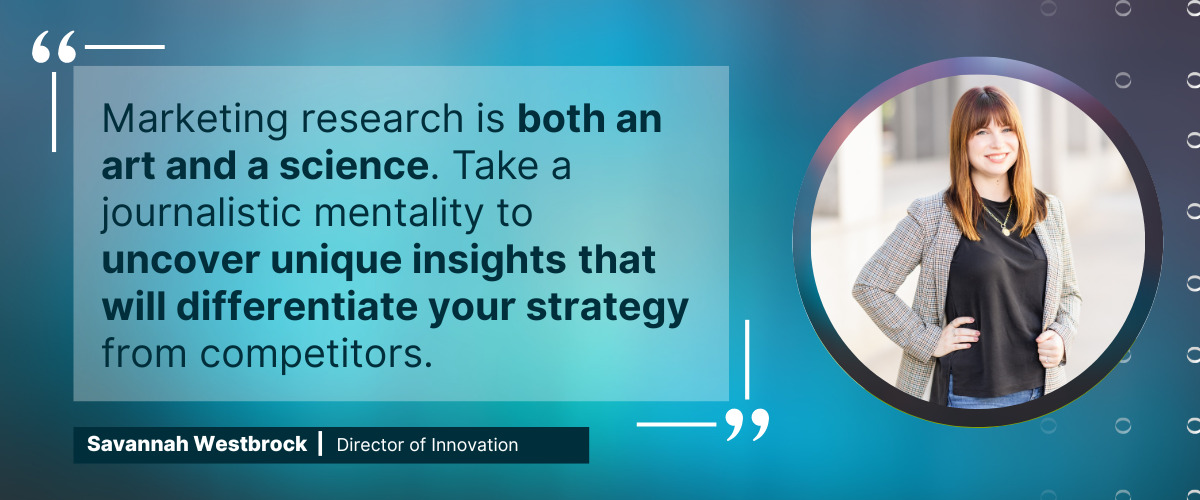The tools we use to conduct marketing research and understand our target audiences and industries are constantly evolving. Traditionally, syndicated research tools have been the go-to resources to understand media consumption and behaviors.
But brand challenges require much more than knowing how many hours a day consumers watch TV to put together a successful marketing strategy.
How to Find Meaningful Marketing Research Insights
Use both qualitative research and quantitative research to unveil unique marketing trends and audience learnings for brands. From social listening tools to focus groups to macro-level industry reports, you need multiple sources to achieve a 360 degree view with your marketing research. Instead of always turning to the same default tools and platforms, take on a journalistic mentality and get creative to discover unique insights that will differentiate your strategy from competitors.
Lean into your creative side. Use out of the box tactics to search for answers to questions such as:
- What’s the press coverage on this topic?
- What changes are happening in the vertical?
- What’s happening in adjacent industries?
From this type of information sourcing, you can then better contextualize the second or third party data embedded in syndicated research and build custom insights for your brand.
It’s also important to look at your own historical first party data, when available. Evaluate what’s been successful and not in order to provide a starting point to build baseline learnings.
Balancing the Art and Science of Market Research
Marketing research is both an art and a science. You need some specific numbers to justify assumptions and hypotheses. But there’s also an element of simply trusting your intuition. A lot of times it’s right and a lot cheaper than running complex, time consuming studies. Your team’s instinct and experience is going to become increasingly valuable in finding insights and closing the gaps.
Sometimes, simply putting yourself in your audience’s shoes and mimicking their behaviors reveals more than any survey could tell you. As an example, if your audience are heavy Twitter users and the data indicates they use certain hashtags – actually read through that content. Go to the subreddits they might frequent. Watch the Hulu shows they’re watching. Use this time of exploration to see if you can unveil something new about how your audience is living day to day.

Avoiding Research Pitfalls
With so much data available, you can use research to essentially prove any point you want. This makes it easy for bias to creep into statistics, intentional or not. If you think the audience is Millennial Moms, there will undoubtedly be evidence somewhere pointing to confirm this assumption.
To avoid this, be transparent when your data does not back up your hypothesis. This is one of the more powerful things you can do to form trusting relationships with your colleagues and clients. It’s okay to admit if the research is refuting your initial assumption. Use this as an opportunity to build a bridge with this learning and adjust your strategy to continue making your marketing smarter.
Additionally, when using third-party studies, it’s important to remember that people answering surveys aren’t always going to be completely truthful about their media consumption or lifestyle. Take a step back before blindly trusting what you’re reading and hearing.
Watch this video for more tips on avoiding common research mistakes:
Finding the Big Idea
Strategists are always digging for the ‘big idea’. The groundbreaking tactic, message, or plan the world has never seen before and will make you millions. If you have a predestined big idea in your head, don’t let that blind you from finding something even better. You need to ground yourself by exploring a variety of research sources without forcing anything. Allow the data to weave together a story rather than reverse engineering your predetermined story to create a successful path forward for your brand.
Key Takeaways
In the impending privacy-first marketing landscape, there will be more emphasis on planning and finding the right research. Decision making is coming back to the hands of marketers, rather than left to platform algorithms.
Take a balanced, creative approach to the market research process and unlock the most meaningful insights to improve your bottom line and build customer loyalty.
To hear more about Coegi’s approach to marketing research, contact us for a discovery call today.






